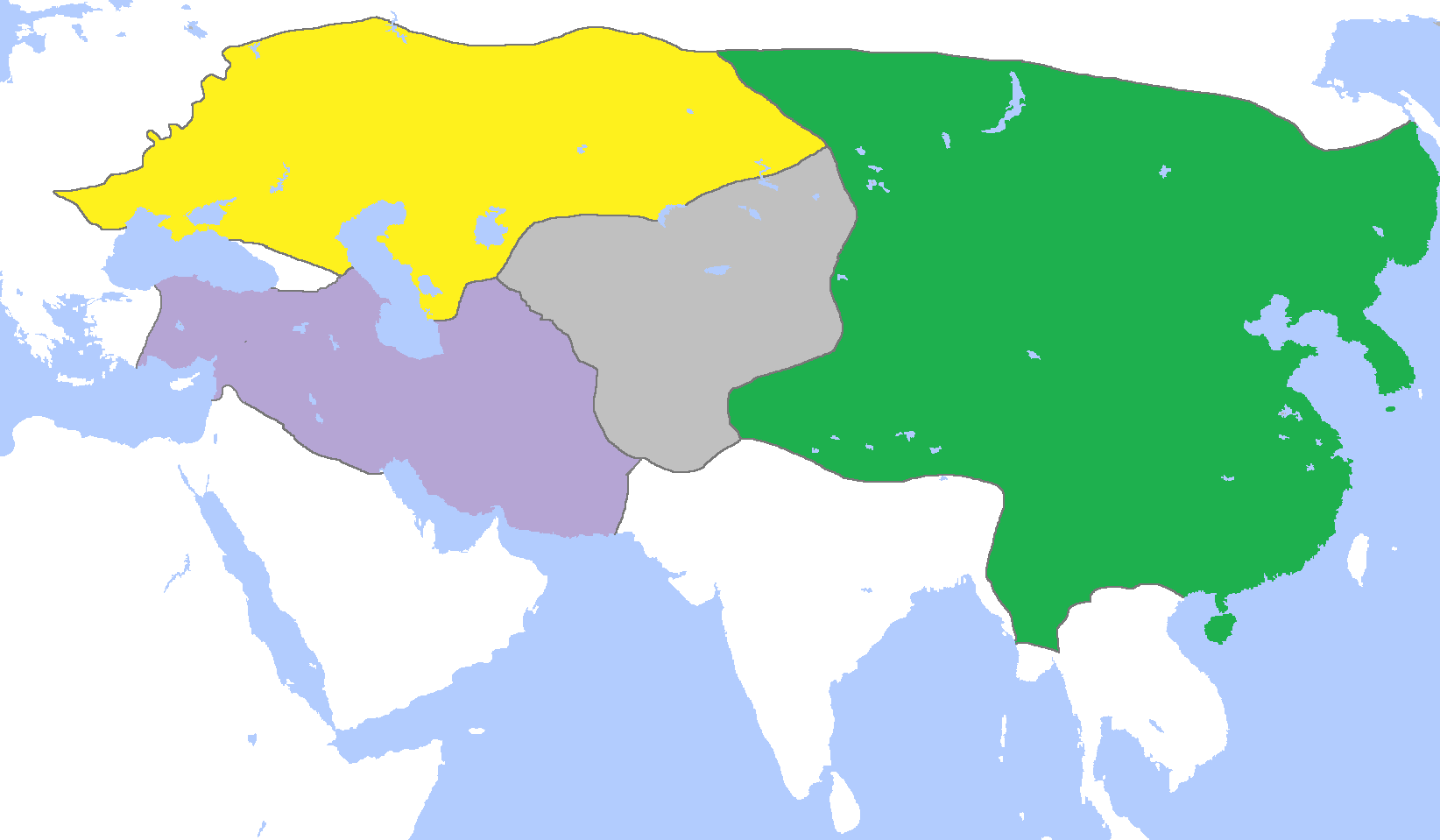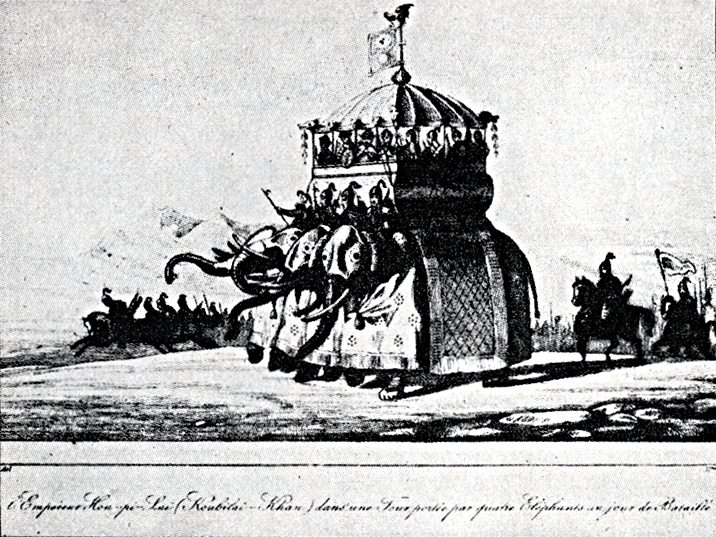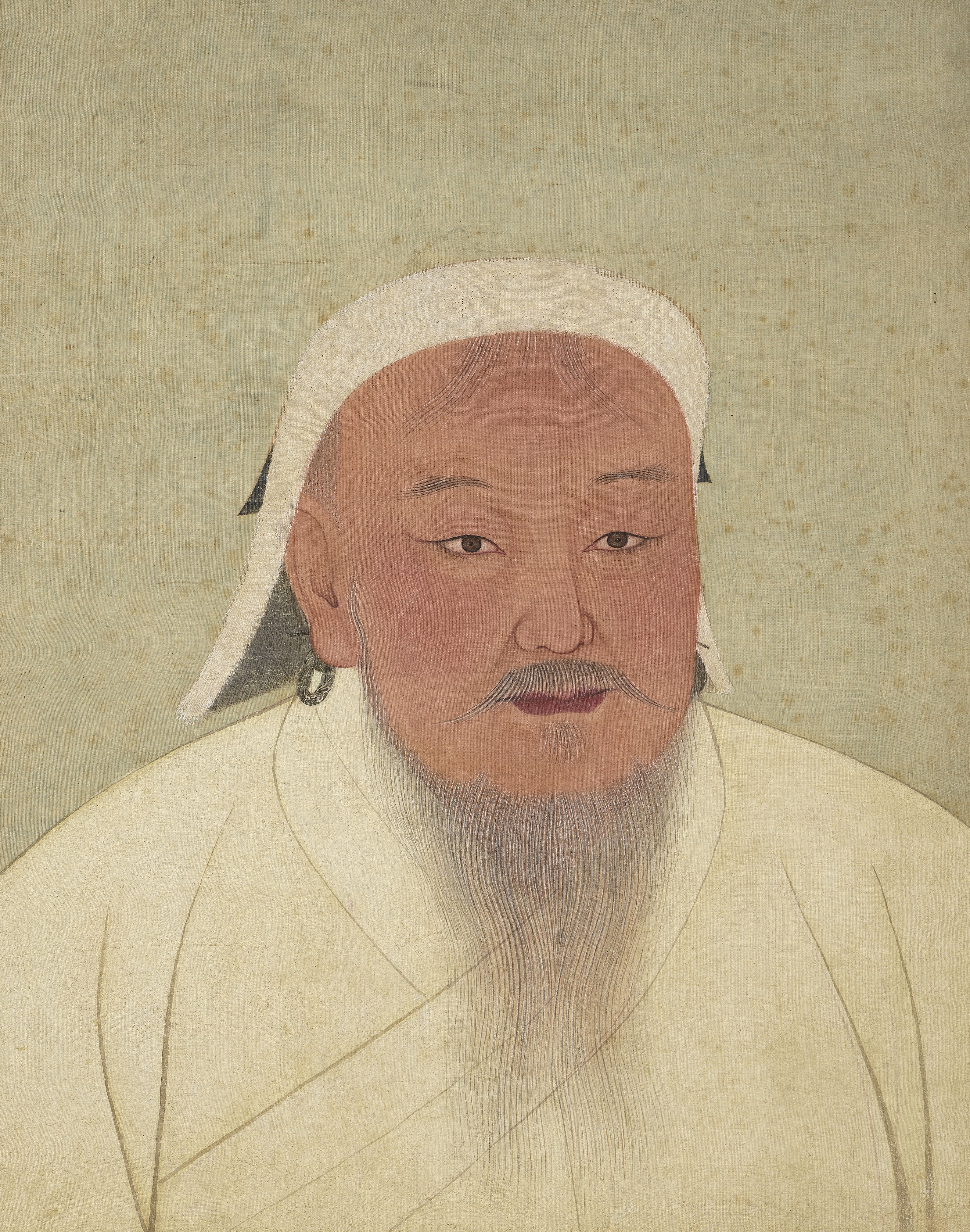|
Shiregi
Shiregi (, , , ) was a Mongol prince from the Borjigin clan, great-grandson of Genghis Khan. Biography Shiregi was born to Möngke Khan and his concubine Bayavchin from Bayaut tribe at unknown time. Initially a supporter of Ariq Böke, he defected to Kublai Khan, for which he was created King of Heping (河平王) in 1267. As soon as Kaidu-Kublai war started he was sent against Kaidu. He arrived together with Nomoghan (son of Kublai), Kököchu (son of Kublai) and Antong (grandson of Muqali) in 1275, Almaliq. However, soon in Autumn 1276 Shiregi was incited by Togh-Temür, another grandson of Tolui to rise against Kublai and claim the empire. Shiregi defeated the princes, sent Nomoghan and Antong to Mengu-Timur of Golden Horde and Kaidu. However, Kaidu refused to join Shiregi in his bid to throne, so they went to Upper Yenisei region to use it as a base to capture Karakorum later.{{Cite book, last=Rossabi, first=Morris, url=https://books.google.com/books?id=u6gwDwAAQBAJ, title= ... [...More Info...] [...Related Items...] OR: [Wikipedia] [Google] [Baidu] |
Bayan Of The Baarin
Bayan of the Baarin (Mongolian language, Mongolian: Баян; 1236 – January 11, 1295), or Boyan () was an ethnic Mongols, Mongol general of the Yuan dynasty of China. He was known to Marco Polo as "Bayan Hundred Eyes" (probably from a confusion with ). He commanded the army of Kublai Khan against the Song dynasty#Southern Song, 1127–1279, Southern Song dynasty, ushering in the Southern Song collapse and the conquest of southern China by the Yuan dynasty. "Bayan" literally means "rich" in the Mongolian language. Background Born a grandnephew of Nayagha, a general under Genghis Khan, Bayan came from the Mongol Baarin tribe. Nayagha, together with Bayan's grandfather Alagh and Alagh's and Nayagha's father Shirgügetü Ebügen, appear in the ''Secret History of the Mongols''. Early career His grandfather Alagh was the viceroy in Khorazm province under the Mongol Empire. Bayan's father died during the Mongol siege of the stronghold of the Assassins (sect), Assassins (''Has ... [...More Info...] [...Related Items...] OR: [Wikipedia] [Google] [Baidu] |
Kaidu–Kublai War
Kaidu, the leader of the Mongol House of Ögedei, fought a war against Kublai Khan and his successor Temür from 1268 to 1301. Kaidu was the de facto khan of the Chagatai Khanate, while Kublai was the founder of the Yuan dynasty. The Kaidu–Kublai war followed the Toluid Civil War (1260–1264) and resulted in the permanent division of the Mongol Empire. By the time of Kublai's death in 1294, the Mongol Empire had fractured into four separate polities: the Golden Horde khanate in the northwest, the Chagatai Khanate in the middle, the Ilkhanate in the southwest, and the Yuan dynasty in the east based in modern-day Beijing. Although Temür later made peace with the three western khanates in 1304 after Kaidu's death, the four successor states of the Mongol Empire continued their own separate development and fell at different times. History Chagatai–Ilkhanid war After the Toluid Civil War, Kublai Khan summoned Kaidu at his court, but Kaidu avoided appearing at his court, ... [...More Info...] [...Related Items...] OR: [Wikipedia] [Google] [Baidu] |
Mengu-Timur
Mengu-Timur ( ) or Möngke Temür (; died 1280) was a son of Toqoqan Khan (himself the son of Batu) and Köchu Khatun of Oirat, the daughter of Toralchi Küregen and granddaughter of Qutuqa Beki. Mengu-Timur was a khan of the Golden Horde, a division of the Mongol Empire in 1266–1280. His name literally means "Eternal Iron" in the Mongolian language. Early reign and foreign policy During his reign, the Mongols together with their subjects, several Turkic tribes and the Russian princes, undertook military campaigns against Byzantium (c. 1269–1271), Lithuania (1275), and the Alans in the Caucasus (1277). The very first '' yarlyk'' (a license or written commandant of Mongol and Chinggisid rulers) found by historians was written on behalf of Mengu-Timur and contained information on the release of the Russian Church from paying tribute to the Golden Horde, even though he was a shamanist. During the reign of Mengu-Timur, the Genoese traders purchased Caffa from the Mong ... [...More Info...] [...Related Items...] OR: [Wikipedia] [Google] [Baidu] |
Kublai Khan
Kublai Khan (23 September 1215 – 18 February 1294), also known by his temple name as the Emperor Shizu of Yuan and his regnal name Setsen Khan, was the founder and first emperor of the Mongol-led Yuan dynasty of China. He proclaimed the dynastic name "Great Yuan" in 1271, and ruled Yuan China until his death in 1294. Kublai was the second son of Tolui by his chief wife Sorghaghtani Beki, and a grandson of Genghis Khan. He was almost 12 when Genghis Khan died in 1227. He had succeeded his older brother Möngke as Khagan in 1260, but had to defeat his younger brother Ariq Böke in the Toluid Civil War lasting until 1264. This episode marked the beginning of the division of the Mongol Empire. Kublai's real power was limited to the Yuan Empire, even though as Khagan he still influenced the Ilkhanate and, to a significantly lesser degree, the Golden Horde. In 1271, Kublai established the Yuan dynasty and formally claimed orthodox succession from prior Chinese dynasties. ... [...More Info...] [...Related Items...] OR: [Wikipedia] [Google] [Baidu] |
Kaidu
Kaidu (; Middle Mongol: , Modern Mongol: , ''Khaidu'' ; c. 1235 – 1301) was a grandson of the Mongol khagan Ögedei (1185–1241) and thus leader of the House of Ögedei and the '' de facto'' khan of the Chagatai Khanate, a division of the Mongol Empire. He ruled parts of modern-day Xinjiang and Central Asia during the 13th century, and actively opposed his cousin, Kublai, who established the Yuan dynasty. Medieval chroniclers often mistranslated Kadan as Kaidu, mistakenly placing Kaidu at the Battle of Legnica. Kadan was the brother of Güyük, and Kaidu's uncle. Chambers, James. ''The Devil's Horsemen: The Mongol Invasion of Europe''. Atheneum. New York. 1979. Early life Kaidu was born in c. 1235 during the reign of his grandfather, the Great Khan Ögedei. Kaidu was the posthumous son of the Mongol Prince Kashin, who was himself the 4th son of Ögedei and his chief consort, the Great Khatun Töregene, and thus a vital part of the House of Ögedei even in his earl ... [...More Info...] [...Related Items...] OR: [Wikipedia] [Google] [Baidu] |
Möngke Khan
Möngke Khan (also Möngke Khagan or Möngke; 11 January 120911 August 1259) was the fourth khagan of the Mongol Empire, ruling from 1 July 1251 to 11 August 1259. He was the first Khagan from the Toluid line, and made significant reforms to improve the administration of the Empire during his reign. Under Möngke, the Mongols conquered Iraq and Syria as well as the kingdom of Dali (modern Yunnan). Early life Möngke was born on 11 January 1209, as the eldest son of Genghis Khan's teenaged son Tolui and Sorghaghtani Beki. Teb Tengri Khokhcuu, a shaman, claimed to have seen in the stars a great future for the child and bestowed on him the name Möngke, meaning 'eternal' in Mongolian. His uncle Ögedei Khan's childless queen Angqui raised him at her orda (nomadic palace). Ögedei instructed Persian scholar Idi-dan Muhammed to teach writing to Möngke. On his way back home after the Mongol conquest of Khwarezmia, Genghis Khan performed a ceremony on his grandsons Möngke and ... [...More Info...] [...Related Items...] OR: [Wikipedia] [Google] [Baidu] |
Borjigin
A Borjigin is a member of the Mongol sub-clan that started with Bodonchar Munkhag of the Kiyat clan. Yesugei's descendants were thus said to be Kiyat-Borjigin. The senior Borjigids provided ruling princes for Mongolia and Inner Mongolia until the 20th century.Humphrey & Sneath, p. 27. The clan formed the ruling class among the Mongols and some other peoples of Central Asia and Eastern Europe. Today, the Borjigid are found in most of Mongolia, Inner Mongolia and Xinjiang, and genetic research has shown that descent from Genghis Khan and Timur is common throughout Central Asia and other regions. Origin and name The patrilineage began with Blue-grey Wolf (Börte Chino) and Fallow Doe (Gua Maral). According to '' The Secret History of the Mongols'', their 11th generation descendant Dobu Mergen's widow Alan Gua the Fair was impregnated by a ray of light. Her youngest son became the ancestor of the later Borjigid. He was Bodonchar Munkhag, who along with his brothers s ... [...More Info...] [...Related Items...] OR: [Wikipedia] [Google] [Baidu] |
Yuan Dynasty Generals
Yuan may refer to: Currency * Yuan (currency), the basic unit of currency in historic and contemporary mainland China and Taiwan ** Renminbi, the currency of modern mainland China, whose basic unit is yuan ** New Taiwan dollar, the currency used in modern Taiwan, whose basic unit is yuán in Mandarin ** Manchukuo yuan, the unit of currency that was used in the Japanese puppet state of Manchukuo ** Gold yuan, the unit of currency that was used in the Republic of China between 1948 and 1949 * Yen and yuan sign (¥), symbol used for yuan currency in Latin scripts Governmental organ * " Government branch" or "Court" (), the Chinese name for a kind of executive institution. Government of Taiwan * Control Yuan * Examination Yuan * Executive Yuan * Judicial Yuan * Legislative Yuan Government of Imperial China * Xuanzheng Yuan, or Bureau of Buddhist and Tibetan Affairs during the Yuan dynasty * Lifan Yuan during the Qing dynasty Dynasties * Yuan dynasty (元朝), a dynasty of China ru ... [...More Info...] [...Related Items...] OR: [Wikipedia] [Google] [Baidu] |
13th-century Mongols
The 13th century was the century which lasted from January 1, 1201 (represented by the Roman numerals MCCI) through December 31, 1300 (MCCC) in accordance with the Julian calendar. The Mongol Empire was founded by Genghis Khan, which stretched from Eastern Asia to Eastern Europe. The conquests of Hulagu Khan and other Mongol invasions changed the course of the Muslim world, most notably the Siege of Baghdad (1258) and the destruction of the House of Wisdom. Other Muslim powers such as the Mali Empire and Delhi Sultanate conquered large parts of West Africa and the Indian subcontinent, while Buddhism witnessed a decline through the conquest led by Bakhtiyar Khilji. The earliest Islamic states in Southeast Asia formed during this century, most notably Samudera Pasai. The Kingdoms of Sukhothai and Hanthawaddy would emerge and go on to dominate their surrounding territories. Europe entered the apex of the High Middle Ages, characterized by rapid legal, cultural, and religious e ... [...More Info...] [...Related Items...] OR: [Wikipedia] [Google] [Baidu] |
Karakorum
Karakorum (Khalkha Mongolian: Хархорум, ''Kharkhorum''; Mongolian script:, ''Qaraqorum'') was the capital city, capital of the Mongol Empire between 1235 and 1260 and of the Northern Yuan, Northern Yuan dynasty in the late 14th and 15th centuries. Its ruins lie in the northwestern corner of the Övörkhangai Province of modern-day Mongolia, near the present town of Kharkhorin and adjacent to the Erdene Zuu Monastery, which is likely the oldest surviving Buddhist monastery in Mongolia. They are located in the upper part of the World Heritage Site Orkhon Valley. History Founding The Orkhon valley was a center of the Xiongnu, Göktürks, Göktürk, and Uyghur Empire, Uyghur empires. To the Göktürks, the nearby Khangai Mountains had been the location of the Ötüken (the locus of power), and the Uyghur capital Karabalgasun was located close to where later Karakorum would be erected (downstream the Orkhon River 27 km north–west from Karakorum). This area is ... [...More Info...] [...Related Items...] OR: [Wikipedia] [Google] [Baidu] |
Golden Horde
The Golden Horde, self-designated as ''Ulug Ulus'' ( in Turkic) was originally a Mongols, Mongol and later Turkicized khanate established in the 13th century and originating as the northwestern sector of the Mongol Empire. With the division of the Mongol Empire after 1259, it became a functionally separate khanate. It is also known as the Kipchak Khanate or the Ulus of Jochi, and replaced the earlier, less organized Cuman–Kipchak confederation. After the death of Batu Khan (the founder of the Blue Horde) in 1255, his dynasty flourished for a full century, until 1359, though the intrigues of Nogai Khan, Nogai instigated a partial civil war in the late 1290s. The Horde's military power peaked during the reign of Özbeg Khan (1312–1341), who adopted Islam. The territory of the Golden Horde at its peak extended from Siberia and Central Asia to parts of Eastern Europe from the Ural Mountains, Urals to the Danube in the west, and from the Black Sea to the Caspian Sea in the south ... [...More Info...] [...Related Items...] OR: [Wikipedia] [Google] [Baidu] |
Almaliq, Xinjiang
Almaliq (; zh, t=, p=Ālìmálǐ),Previously transcribed into Chinese as , ''Ā'ěrmǎlì''; , ''Ālǐmǎchéng''; , ''Ālǐmá'' and , ''Ālìmǎlì''. also spelled Almalik, Almalig, was a medieval city in the Ili basin in present-day Huocheng County, Xinjiang, China along Kazakhstan border. A modern town named Alimali (阿力玛里) in Khorgas, adjacent to Huocheng, has no historical connections with the medieval town. History Almaliq was originally one of Karluk cities in the Turkic Kaganates. It is known from the accounts of the Persian historians and Chinese travelers of the Mongol era (13th to 15th centuries), in particular the 13th-century Daoist Qiu Chuji (Chang Chun). According to the travel notes of Genghis Khan's chief adviser Yelü Chucai, the city of Almaliq was situated between the Tian Shan mountains and the Ili River. There were many crab apple trees around Almalik. The native people called them "almaliq", thus giving the name to the city. An acco ... [...More Info...] [...Related Items...] OR: [Wikipedia] [Google] [Baidu] |





